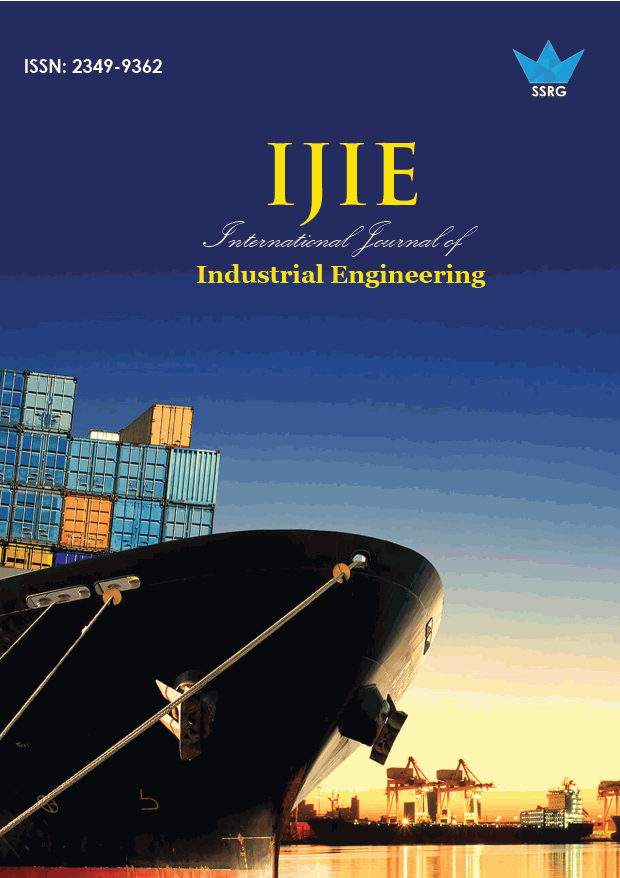Case Study on the Supply Chain Resilience of Potential Hidden-Champion Enterprises in Taiwan

| International Journal of Industrial Engineering |
| © 2023 by SSRG - IJIE Journal |
| Volume 10 Issue 1 |
| Year of Publication : 2023 |
| Authors : Ping-Hsin Fan |
How to Cite?
Ping-Hsin Fan, "Case Study on the Supply Chain Resilience of Potential Hidden-Champion Enterprises in Taiwan," SSRG International Journal of Industrial Engineering, vol. 10, no. 1, pp. 11-19, 2023. Crossref, https://doi.org/10.14445/23499362/IJIE-V10I1P103
Abstract:
Enterprises will face the risk of disrupted supply chains in the case of major crises. In recent years, global industries have suffered major economic losses and even mass casualties in many events, such as the 2011 earthquake and tsunami in Japan and the COVID-19 pandemic, from which many economic and commercial activities have not completely recovered. Global major crises are happening more frequently due to a number of factors, such as environment, climate, politics, and pandemic factors, among others. To this end, the supply chain resilience issue is attracting great attention from various industries. Taiwan enterprises play a vital role in the global manufacturing supply chain and are so-called hidden champions. This research implemented a case study on three potential hidden-champion enterprises in Taiwan to analyze their supply chain vulnerabilities and capabilities, respectively, and further identify their supply chain resilience. In addition, this study summarized the five resilience features of these three enterprises through the interview and questionnaire contents for reference of various industries.
Keywords:
Disrupted supply chain, Supply chain resilience, Hidden champions, Vulnerabilities, Capabilities.
References:
[1] The BBC Website, 2019. [Online]. Available: https://www.bbc.com/zhongwen/trad/world-49986037.
[2] S. F. Yang, “Development Trend of Resilient Supply Chain and Taiwan's Responses,” Economic Outlook Bimonthly, vol. 198, pp. 24-29, 2021.
[3] Shashank Rao, and Thomas J. Goldsby, “Supply Chain Risks: A Review and Typology,” The International Journal of Logistics Management, vol. 20, no. 1, pp. 97-123, 2009.
[CrossRef] [Google Scholar] [Publisher Link]
[4] Venkatachalam Anbumozhi, Fukunari Kimura, and Shandre Mugan Thangavelu, Supply Chain Resilience: Reducing Vulnerability to Economic Shocks, Financial Crises, and Natural Disasters, Springer, Singapore, 2020.
[CrossRef] [Google Scholar] [Publisher Link]
[5] U. Jüttner, and S. Maklan, “Supply Chain Resilience in the Global Financial Crisis: An Empirical Study,” Supply Chain Management, vol. 16, no. 4, pp. 246-259, 2011.
[CrossRef] [Google Scholar] [Publisher Link]
[6] Martin Christopher, and Helen Peck, “Building the Resilient Supply Chain,” International Journal of Logistics Management, vol. 15, no. 2, pp. 1-13, 2004.
[CrossRef] [Google Scholar] [Publisher Link]
[7] J. T. Hsu, “Keep "Extra", is the Key to Develop Organization Resilience? BCG Points Out 2021 New Appearance of the Supply Chain,” Manager Today, 2021.
[8] James B Rice, and Federico Caniato, “Building a Secure and Resilient Supply Network,” Supply Chain Management Review, vol. 7, no. 5, pp. 22-30, 2003.
[Google Scholar] [Publisher Link]
[9] Yossi Sheffi, The Resilient Enterprise: Overcoming Vulnerability for Competitive Advantage, Cambridge. MA: MIT Press, 2005.
[Google Scholar] [Publisher Link]
[10] Joseph Fiksel, “Sustainability and Resilience: Toward a Systems Approach,” Sustainability: Science Practice and Policy, vol. 2, no. 2, 2006.
[CrossRef] [Google Scholar] [Publisher Link]
[11] Susan Lund et al., Risk, Resilience, and Rebalancing in Global Value Chains, McKinsey Global Institute, 2020.
[Google Scholar] [Publisher Link]
[12] Paul Michelman, and Yossi Sheffi, “Building a Resilient Supply Chain,” Harvard Business Review, 2007.
[Publisher Link]
[13] BSI, Organizational Resilience Index Report 2021, BSI Group, 2021.
[Publisher Link]
[14] Randy Starr, Jim Newfrock, and Michael Delurey, “Enterprise Resilience: Managing Risk in the Networked Economy,” Strategy Business, vol. 30, no. 1, pp. 1-150, 2003.
[Google Scholar] [Publisher Link]
[15] Stephan M. Wagner, and Christoph Bode, “An Empirical Examination of Supply Chain Performance along Several Dimensions of Risk,” Journal of Business Logistics, vol. 29, no. 1, pp. 307-325, 2008.
[CrossRef] [Google Scholar] [Publisher Link]
[16] Ila Manuj, and John T. Mentzer, “Global Supply Chain Risk Management,” Journal of Business Logistics, vol. 29, no. 1, pp. 133-155, 2008.
[CrossRef] [Google Scholar] [Publisher Link]
[17] V. Anbumozhi, “Engendering Resilient and Sustainable ASEAN,” Framing the ASEAN Sociocultural Community Post, 2015.
[Publisher Link]
[18] R. Smith, “Operational Capabilities for the Resilient Supply Chain,” Supply Chain Practice, vol. 6, no. 2, pp. 24-35, 2004.
[Google Scholar]
[19] Andrew Cox, “Power, Value and Supply Chain Management,” Supply Chain Management, vol. 4, no. 4, pp. 167-175, 1999.
[CrossRef] [Google Scholar] [Publisher Link]
[20] Yimin Wang, Wendell Gilland, and Brian Tomlin, “Mitigating Supply Risk: Dual Sourcing or Process Improvement?,” Manufacturing & Service Operations Management, vol. 12, no. 3, pp. 489-510, 2010.
[CrossRef] [Google Scholar] [Publisher Link]
[21] Uta Jüttner, “Supply Chain Risk Management-Understanding the Business Requirements from a Practitioner Perspective,” International Journal of Logistics Management, vol. 16, no. 1, pp. 120-141, 2005.
[CrossRef] [Google Scholar] [Publisher Link]
[22] Helen Peck, “Drivers of Supply Chain Vulnerability: An Integrated Framework,” International Journal of Physical Distribution & Logistics Management, vol. 35, no. 4, pp. 210-232, 2005.
[CrossRef] [Google Scholar] [Publisher Link]
[23] Hulas Raj Tonday, Poonam D. Katore, Dipali S. Raut, Akash D. Rathod, Anuja I. Morwal, "Study of Implementation of Agile Supply Chain For Efficient Delivery of Essentials During Covid-19," SSRG International Journal of Mechanical Engineering, vol. 8, no. 8, pp. 1-5, 2021.
[CrossRef] [Google Scholar] [Publisher Link]
[24] Hermann Simon, Hidden Champions of the 21st Century: The Success Strategies of Unknown World Market Leaders, Springer, US, 2009.
[CrossRef] [Google Scholar] [Publisher Link]
[25] The Taiwan Website, 2021. [Online]. Available: https://www.mittelstand.org.tw/index.php
[26] Timothy J. Pettit, Keely L. Croxton, and Joseph Fiksel, “Ensuring Supply Chain Resilience: Development and Implementation of an Assessment Tool,” Journal of Business Logistics, vol. 34, no. 1, pp. 46-76, 2013.
[CrossRef] [Google Scholar] [Publisher Link]
[27] Nguyen Thi Kim Huyen, "Financial Management of Supply Chains in Vietnam: A Case Study of Companies in the Steel Industry," SSRG International Journal of Economics and Management Studies, vol. 7, no. 12, pp. 56-61, 2020.
[CrossRef] [Publisher Link]
[28] Timothy J. Pettit, “Supply Chain Resilience: Development of a Conceptual Framework, an Assessment Tool and an Implementation Process,” University of Ohio State, Business Administration, 2008.
[Google Scholar] [Publisher Link]

 10.14445/23499362/IJIE-V10I1P103
10.14445/23499362/IJIE-V10I1P103